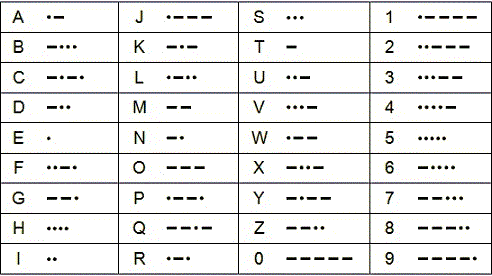The enigmatic realm of Morse code, an asylum of dots and dashes, beckons individuals to explore its linguistic fabric. Originating in the early 19th century, Morse code emerged as a revolutionary mode of communication, primarily designed for the telegraph. However, its classification under the umbrella of cryptography has spurred fervent debates among scholars, hobbyists, and curious minds alike. The question lingers: is Morse code a bona fide form of cryptography? Let us unravel the wonders of this intricate code and dissect its position in the vast landscape of cryptographic practices.
Morse code is fundamentally a method of encoding textual information through a series of signals represented by short and long marks: the dot (·) and the dash (−). This binary system allows for the transmission of letters and numbers across various mediums, primarily audio and visual signals. The ingenuity lies in its simplicity and effectiveness; for instance, the letter A is denoted by a dot followed by a dash (·−). Each character is uniquely assigned a combination of these basic units, transforming the alphabet into a decipherable code.
At first glance, Morse code does not adhere to the traditional definitions of cryptography, which typically involves the practice of transforming information into a format that is unreadable to the untrained observer. Classic cryptography often entails more complex algorithms, substitution ciphers, or encryption techniques designed to safeguard information from prying eyes. Nevertheless, Morse code warrants a closer examination to determine the nuances of its classification.
One perspective argues that since Morse code can obscure the original text from individuals unfamiliar with its interpretive rules, it holds traits characteristic of cryptography. An uninitiated individual encountering a string of seemingly random dots and dashes would be incapable of deciphering the intended message without the requisite knowledge of the code. This unacquaintance creates an inherent barrier, akin to those found in conventional cryptographic systems. Thus, one could infer that Morse code indeed functions as a basic form of cryptography by its capacity to obscure meaning.
However, the distinction becomes sharper when considering the motivations behind cryptographic practices. Traditional cryptography is often employed to protect sensitive information, shielded against espionage, fraud, or unauthorized disclosure. The goals of maintaining confidentiality, integrity, and authentication inherently govern cryptographic endeavors. Morse code, on the other hand, primarily serves a communicative function without an intrinsic need to conceal messages from adversaries. Furthermore, it does not inherently provide means of security or authentication; its structure exists solely for encoding purposes, relegating it to a more benign role in the cryptographic hierarchy.
Despite its classification debate, Morse code has historically been intertwined with military and naval communication, where brevity and clarity were paramount. In wartime, the efficient transmission of information could mean the difference between triumph and disaster. Thus, while Morse code suffers from the absence of encryption and security traits that typify sophisticated cryptography, its application in critical communication underscores its significance in tactical environments. The Supreme Commander of Allied Forces during World War II, for instance, relied on Morse code for critical situation updates.
The interplay between ambiguity and clarity deserves further examination. In criminal investigations or espionage, the mere presence of an encoded message can be a provocative element, invoking curiosity and engagement from authorities. This psychological aspect introduces a recent resurgence of interest in Morse code, evident in the increasing prevalence of amateur enthusiasts and hobbyists partaking in decoding attempts. The very act of decoding Morse code transforms a simple textual message into a riddle, a puzzle enticing enough to stimulate cerebral engagement.
Moreover, in the digital age, Morse code’s revival in popular culture cannot be overlooked. From the realm of amateur radio operators to the whimsical engagements in gaming and music, the multi-faceted applications of Morse code breathe life into this vintage code. Hackers and technology explorers have reinterpreted Morse code for modern communication, utilizing it in playful ways while simultaneously fostering a sense of nostalgia. This cyclical renaissance invites fresh scrutiny into whether such applications lend Morse code a robust contemporaneous identity within the cryptographic domain.
In conclusion, the debate surrounding the classification of Morse code as cryptography remains multifaceted. While it embodies elements that obscure meaning, its absence of protective measures and security vulnerabilities distinguishes it from traditional cryptographic mechanisms. Nonetheless, the remarkable adaptability of Morse code facilitates its inclusion as an informal variant of cryptography, an entry point into the broader realm of encoded communication. By piquing our interest in its historical significance and reimagining its modern applications, Morse code continues to resonate within the narrative of encrypted mechanisms. As the world becomes increasingly data-driven, the timeless appeal of Morse code shall undoubtedly endure, positioning it as a fascinating subject ripe for exploration in both cryptographic and communication studies.








Leave a Comment